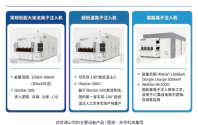Kaishitong Ion Implantation Matrix

Kaishitong leads the industrialization of domestic integrated circuit ion implanters. The company has developed and mass-produced a series of products such as low-energy, large-beam ion implanters and high-energy ion implanters, filling the domestic gap. It is at the forefront of domestic production in terms of equipment installed capacity, performance and stability, and has achieved full coverage of various chip processes such as logic, storage, power, CIS image sensors, etc.
At this year's SEMICON China exhibition, Kaishitong brought a full range of integrated circuit ion implanter product matrix. Through long-term technical research and mass production applications, Kaishitong ion implanters have been continuously upgraded and iterated in key technologies such as ion source, optical system, wafer transmission, particle contamination control, and software automation. Key performance indicators have been continuously improved, and have been widely recognized by wafer fab customers.
In terms of technological breakthroughs, Kaisitong has previously achieved the industrialization of domestic ultra-low temperature ion implantation machines, breaking the foreign technology monopoly. Recently, the company has successfully obtained the verification and acceptance of the new model CIS ion implantation machine, achieving an important breakthrough in the domestic CIS ion implantation machine and promoting the domestic ion implantation machine technology research and development and industrialization to a new level.
At this year's SEMICON China exhibition, Kaishitong brought a full range of integrated circuit ion implanter product matrix. Through long-term technical research and mass production applications, Kaishitong ion implanters have been continuously upgraded and iterated in key technologies such as ion source, optical system, wafer transmission, particle contamination control, and software automation. Key performance indicators have been continuously improved, and have been widely recognized by wafer fab customers.
In terms of technological breakthroughs, Kaisitong has previously achieved the industrialization of domestic ultra-low temperature ion implantation machines, breaking the foreign technology monopoly. Recently, the company has successfully obtained the verification and acceptance of the new model CIS ion implantation machine, achieving an important breakthrough in the domestic CIS ion implantation machine and promoting the domestic ion implantation machine technology research and development and industrialization to a new level.






